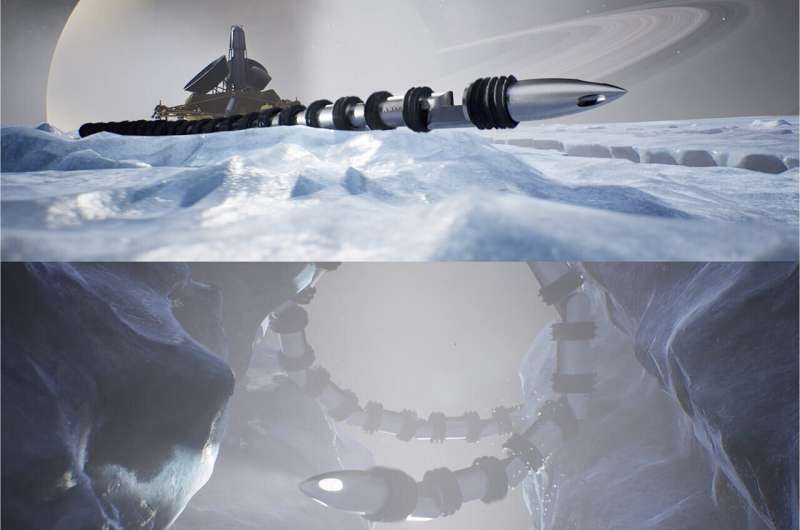March 20, 2024 report
This article has been reviewed according to Science X's editorial process and policies. Editors have highlighted the following attributes while ensuring the content's credibility:
fact-checked
peer-reviewed publication
trusted source
proofread
A snake-like robot designed to look for life on Saturn's moon

A team of roboticists at California Institute of Technology's Jet Propulsion Laboratory, working with a colleague from Carnegie Mellon University's, Robotic Institute, has developed a snake-like robot to investigate the terrain on Enceladus, Saturn's sixth-largest moon.
In their paper published in the journal Science Robotics, the group describes how the robot was designed to specifically travel across the type of icy terrain that the robot would face on Enceladus.
Enceladus is mostly covered in ice. Prior research has shown that the moon has a widely varied surface, including flat stretches, ridges caused by ice masses pushing against one another, and craters caused by asteroid strikes.
Most recently, researchers have found that Enceladus also has a subsurface ocean and probes have observed water-based plumes spurting in its southern regions. These latest findings have scientists wondering whether the icy moon might harbor some form of life beneath its frosty surface. In this new study, the researchers designed and built a robot prototype to explore Enceladus and seek out signs of life.
The robot prototype is approximately 4 meters long and is composed of a head containing a computer and several segments that make up the body. Segments connect to one another via ball joints that allow them to swivel independently of each other. Each segment is also outfitted with a corkscrew exterior used for locomotion.
The robot, which the team has named Exobiology Extant Life Surveyor (EELS), was designed to run autonomously—it moves across icy terrain by turning its corkscrews, sniffing the ice as it goes. Material that is captured is then tested for the presence of materials and signs of life. EELS also has multiple sensors and cameras to help it choose a path to take—and if it gets stuck, it can also travel in reverse.
The researchers have also added a very high degree of durability. In addition to moving along sometimes difficult terrain, the robot must also be able to withstand temperatures averaging –198°C at noon along the moon's equator. The team has already successfully tested their robot in their lab, at a sandy location and on the Athabasca Glacier in Alberta, Canada.
More information: T. S. Vaquero et al, EELS: Autonomous snake-like robot with task and motion planning capabilities for ice world exploration, Science Robotics (2024). DOI: 10.1126/scirobotics.adh8332
© 2024 Science X Network


















